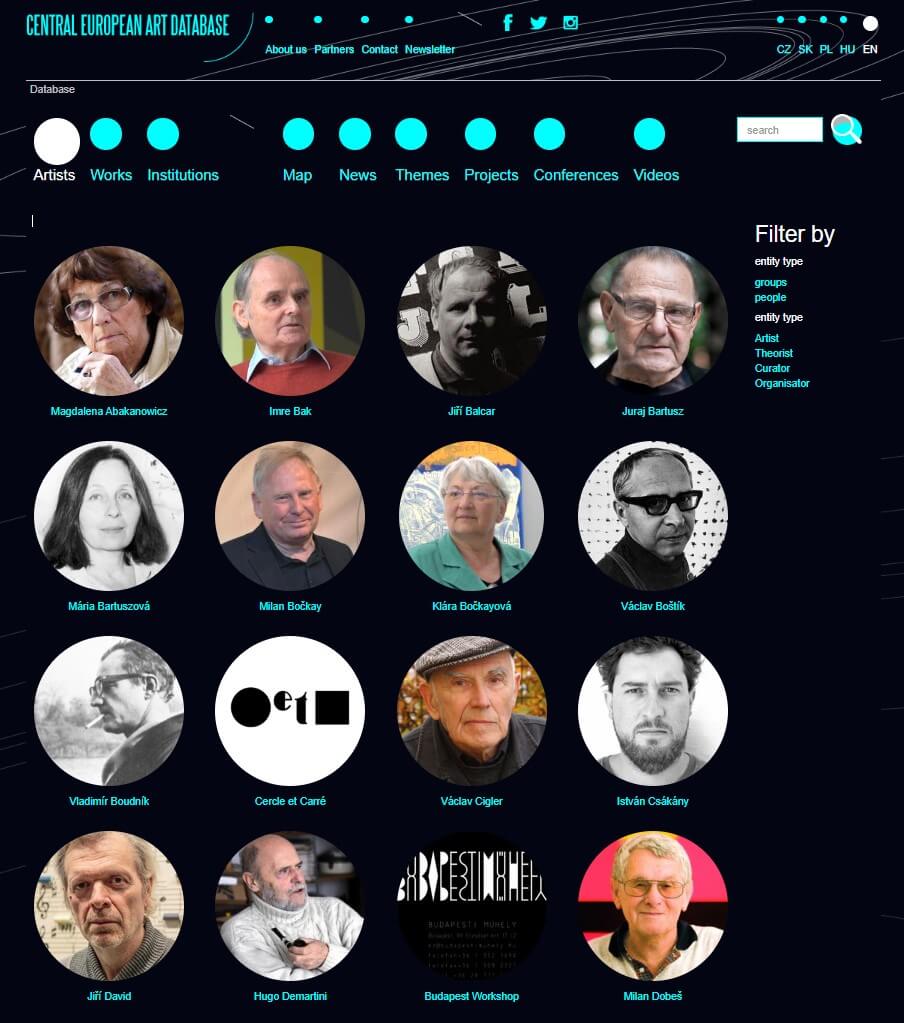Central European Art Database (CEAD)
This database maps out Central European art of the 20th century. It focuses on specific personalities, works, institutions, thematic areas, creative and conceptual groups and events, which it documents, interprets and further mediates to its users. Its main focus is on the period between 1945 and 1989 with overlaps into the first half of the 20th century and contemporary art.
The aim of CEAD (www.cead.space) is to search for and verify the so-called internal characteristics of Central Europe. It derives and illustrates these with specific micro-stories from the life and work of artists, which means through cultural and social ties arising and existing against the background of great historical events of modern times. The database manages what a normal gallery space can reach only very difficult – it is an environment in which the user can enter independently and view the space from his own perspective. It includes archive and documentation material, a reference library, a general timeline, a keyword system and also a selection of audio and video databases.
The CEAD environment is interactive as its goal is among others to motivate users to think independently and critically.
Acquisitions
The Olomouc Museum of Art administrates of almost 200,000 works of art, which ranks it among the most important institutions of its kind in the Czech Republic. We professionally take care of works of the state, the church and of private provenance, from antiquity to contemporary art culture. Modern and contemporary art is the very essence of our main collections. Throughout the existence of the museum, we strive to complete the collections with works by important authors from Central Europe from the post-war period.
This database maps out Central European art of the 20th century. It focuses on specific personalities, works, institutions, thematic areas, creative and conceptual groups and events, which it documents, interprets and further mediates to its users. Its main focus is on the period between 1945 and 1989 with overlaps into the first half of the 20th century and contemporary art.
The aim of CEAD (www.cead.space) is to search for and verify the so-called internal characteristics of Central Europe. It derives and illustrates these with specific micro-stories from the life and work of artists, which means through cultural and social ties arising and existing against the background of great historical events of modern times. The database manages what a normal gallery space can reach only very difficult – it is an environment in which the user can enter independently and view the space from his own perspective. It includes archive and documentation material, a reference library, a general timeline, a keyword system and also a selection of audio and video databases.
The CEAD environment is interactive as its goal is among others to motivate users to think independently and critically.
Acquisitions
The Olomouc Museum of Art administrates of almost 200,000 works of art, which ranks it among the most important institutions of its kind in the Czech Republic. We professionally take care of works of the state, the church and of private provenance, from antiquity to contemporary art culture. Modern and contemporary art is the very essence of our main collections. Throughout the existence of the museum, we strive to complete the collections with works by important authors from Central Europe from the post-war period.
The organization of important international exhibitions, representing the work of relevant artistic personalities from Hungary, Poland and Slovakia, contributed to the expansion of the funds after the year 2000. Thanks to the successful cooperation with partner institutions and also the preparation of representative publications, the museum gained the reputation of a well-founded and reliable partner, and thus was able to concentrate on creating a partner network – institutions and art historians. They played an important role not only in the selection of specific acquisitions, but especially helped us to “open the doors” of artists studios for our research and personal meetings. The selection of works for the SEFO collection is motivated by the effort to obtain the best of Central European works of art after 1945.
Of course, we prefer the direct purchase from the authors. It is a very difficult and demanding journey, but in this way, we are sure that we are gaining unquestionable originals in state collections. Thanks to many years of personal and sometimes even friendly relations, the concept of the SEFO collection fund is being fulfilled, even though the financial conditions for systematic acquisition activities in collection-creating institutions are not optimal.
Victor Vasarely and Magdalena Abakanowicz are undoubtedly among the most important authors of SEFO, as their works are represented in the most prestigious collections of Europe and the USA.
Moreover, the MUO collection was enriched by other works of art by dozens of authors of European significance: Juraj Bartusz (SK), Imre Bak (HU), Dóra Maurer (HU), Milan Bočkay (SK), Zdeněk Sýkora (CZ), Milan Knížák (CZ), Václav Cigler (CZ), Sándor Pinczehelyi (HU), Dezider Tóth (SK), Endre Tót (HU), Otis Laubert (SK), Jana Želibská (CZ), Rudolf Fila (SK), Jerzy Ryszard Zielinski (PL), Eva Kmentová (CZ), Adriena Šimotová (CZ), Włodzimierz Pawlak (PL), László Fehér (HU), Laco Teren (SK) and other.
